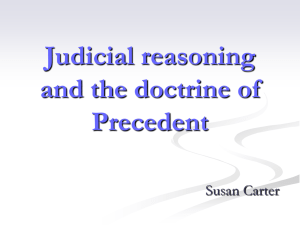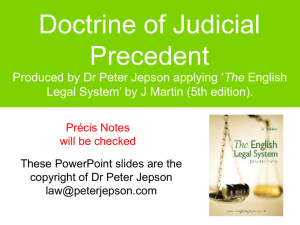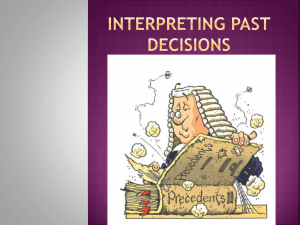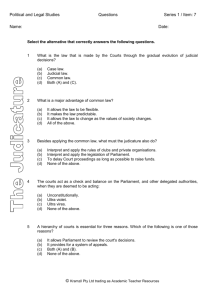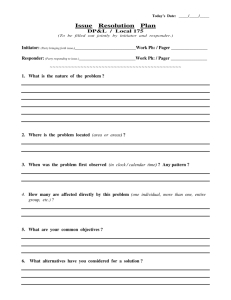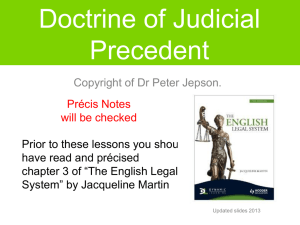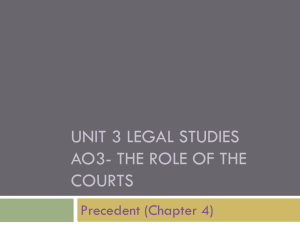Precedent - University of Sydney
advertisement
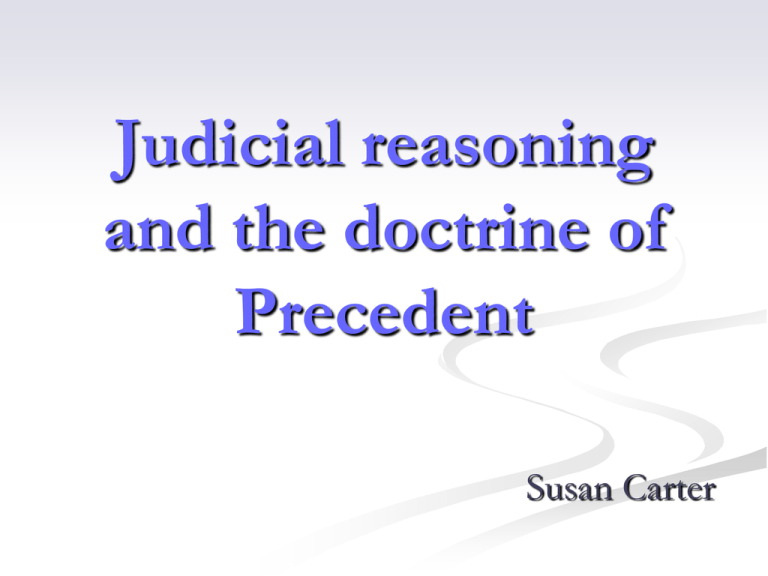
Judicial reasoning and the doctrine of Precedent Susan Carter Precedent The hallmarks of justice are that it should be certain, and should be universal. The doctrine of precedent was developed to provide the necessary certainty and universality. Stare decisis At its heart is a very simple principle: the Law expounded in one case should be followed in later, similar cases. “keep to the rationes decidendi of past cases”, or literally, “stand by the thing which has been decided.” Telstra Corporation v Treloar (2000) 102 FCR 595, per Branson and Finkelstein JJ at 602 The rationale for the doctrine of precedent: Certainty Equality Efficiency And appearance of justice. What is binding? The whole judgment? Everything each judge says? Only the ratio decidendi Ratio? The reason for the decision, or the answer to the question of law before the courts Ratio of this judgment? http://www.youtube.com/watch?v=y_az3eNb0 fI&feature=related Judgment of Solomon Was Solomon answering a question of fact or a question of law? Only answers to questions of law create binding precedent Important distinctions Distinguish between questions of fact and questions of law Ratio decidendi and obiter dicta Obiter is persuasive, not binding Don’t ignore the obiter!!! Precedent and hierarchy Each court is bound by the decisions of higher courts in the same judicial hierarchy How many hierarchies in a federal system? 1. 2. 3. 4. 5. 6. 7. 8. 9. Federal NSW Victorian Qld SA WA Tasmania ACT NT NSW Judicial Hierarchy So is precedent possible in a Federal system? Precedent creates common law NSW common law or common law for all of Australia? Lipohar v R (1999) 200CLR 485 per Gleeson CJ at 505-6 “The common law has its source in the reasons for decisions of the courts which are reasons arrived at according to well recognised and long established judicial methods. It is a body of law created and defined by the courts....the doctrine of precedent is...central to any understanding of the common law in Australia. To assert that there is more than one common law in Australia or that there is a common law of individual States is to ignore the central place which precedent has in both understanding the common law and explaining its basis. This Court is placed by s73 of the Constitution at the apex of a judicial hierarchy to give decisions upon the common law which are binding on all courts, federal, State and territorial. Different intermediate appellate courts within that hierarchy may give inconsistent rulings upon questions of common law. This disagreement will indicate that not all of these courts will have correctly applied or declared the common law. But it does not follow that there are as many bodies of common law as there are intermediate courts of appeal. The situation which arises is not materially different to that which arises where trial judges in different courts or within the same court reach different conclusions on the same point of law. The ultimate foundation of precedent which binds any court to statements of principle, is as Barwick CJ put it, ‘that a court or tribunal higher in the hierarchy of the same juristic system, and thus able to reverse the lower court’s judgement, has laid down that principle as part of the relevant law.’ Until the High Court rules on the matter, the doctrines of precedent which bind the respective courts at various levels below it in the hierarchy will provide a rule for decision. But that does not dictate the conclusion that until there is a decision of the High Court the common law of Australia does not exist,...” Precedent and hierarchy The highest court in a judicial hierarchy can overrule its previous decisions Attitude of High Court Queensland v Commonwealth (1977) 139 CLR 585 per Gibbs J http://www.austlii.edu.au/au/cases/cth/H CA/1977/60.html Read paras [9] –[11] Need for continuity and consistency in judicial decision making 9. It then becomes necessary for me to decide whether I ought to follow the decision of the majority in Western Australia v. The Commonwealth, notwithstanding that I believe it to be wrong. There is of course no doubt that this Court is not bound by its own decisions..... No Justice is entitled to ignore the decisions and reasoning of his predecessors, and to arrive at his own judgment as though the pages of the law reports were blank, or as though the authority of a decision did not survive beyond the rising of the Court..... It is only after the most careful and respectful consideration of the earlier decision, and after giving due weight to all the circumstances, that a Justice may give effect to his own opinions in preference to an earlier decision of the Court. (per Isaacs J at p599) 10. It would be futile to attempt to state any succinct general principle by which the Court should be guided in deciding whether to overrule an earlier decision of its own. ... the Court would be slow to disturb a decision which applied a principle that had been carefully worked out in a succession of cases, and had been more than once reaffirmed. On the other hand, a judgment which had been given per incuriam, and was in conflict with some other decision of the Court, or with some well-established principle, might be readily reviewed. .... But when it is asked what has occurred to justify the reconsideration of a judgment given not two years ago, the only possible answer is that one member of the Court has retired, and another has succeeded him. 11.... the replacement of one Justice by another [should not] in itself justify the review of an earlier decision. Having considered all the circumstances that I have mentioned I have reached the conclusion that it is my duty to follow Western Australia v. The Commonwealth, although in my view it was wrongly decided. And Mabo Mabo v Queensland (No 2) (1992) 175 CLR617 http://www.austlii.edu.au/au/cases/cth/HCA/ 1992/23.html Per Brennan J “…this Court is free to depart from English precedent which was earlier followed as stating the common law of this country…it cannot do so where the departure would fracture what I have called the skeleton of principle….The peace and order of Australian society is built on the legal system. It can be modified to bring it into conformity with contemporary notions of justice and human rights, but it cannot be destroyed.” (at [29]) Decision at same level? A judge does not have to follow the decisions of other judges at the same level in the same judicial hierarchy – these decisions will however be highly persuasive in the interests of consistency. Other hierarchies? A decision of a court in a different hierarchy may be of considerable weight, but will not be binding Expiry date of precedents? Precedents are not necessarily abrogated by lapse of time The rule in Pinnel’s case Part payment of a debt is not sufficient consideration for a promise to discharge the whole debt “…but the gift of a horse, hawk or robe etc might be more beneficial to the plaintiff than the money” Lord Coke in Pinnel’s case Pinnel’s case (1602) 77 ER 237 Expressing the ratio How narrowly do we express the ratio? Is Pinnel’s case only relevant when a hawk is involved? Development of law through precedent Issue for common law Criticism levelled by legal realists among others Previous cases can be: Distinguished Set aside “per incuriam” Overruled by superior court Vocabulary Ratio decidendi/Rationes decidendi Obiter dictum/Obiter dicta Affirm Approve Reverse Overrule Apply Follow/not follow Distinguish

